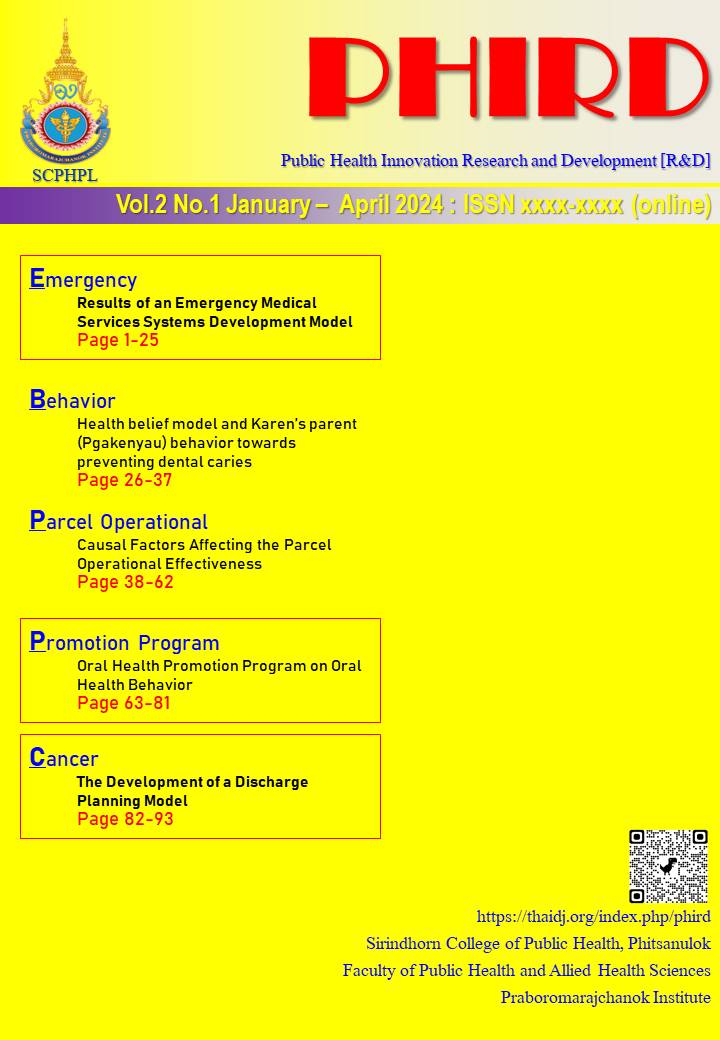Results of an Emergency Medical Services Systems Development Model at the Scene of Wangthong Hospital in Phitsanulok Province
Keywords:
Emergency medical service systems at the scene, Malcolm baldrige national quality awardAbstract
Abstract
Background: Management and service organization of the emergency medical services systems at the scene are critical to the survival and quality of life of people with chronic illnesses. It is important to evaluate and analyze the situation of the service system in order to know the problems and obstacles and to find solutions to develop an effective emergency medical service system.
Aimed: The aim of this study was to develop a emergency medical service systems at the scene of Wangthong Hospital in Phitsanulok Province under the Malcolm Baldrige National Quality Award (MBNQA). The emergency medical service plan was put into the practical by applying to develop systems. The efficiency of the plan was investigated with regard to quality tools i.e., Why-Why Analysis, Critical-to-Quality and Service Quality Model.
Methodology: This study was research and development and was conducted in four stages. The samples in this study research were people who have been injured in emergency medical services at the scene of the accident of the Wangthong Hospital in Phitsanulok Province during 1 September, 2017 to 31 January, 2018. The instruments used for data collection were emergency medical service plan, skill test, and satisfaction interviews. Descriptive statistics such as means, standard deviations were computed, and t-test dependent was used to compare post-test and criteria means.
Results: The findings were as follows: 1) the developed emergency medical service systems at the scene of Wangthong Hospital consisted of nine components; 1) get notified, 2) inquiries for information 3) assess the situation to work out. 4) Reporting command center5) operations of ALS Team 6) operations of FR team and others, 7) assess the situation at the scene. And ask for help 8) first aid and transport of injured persons according to severity level, and 9) Report the situation to the emergency room. 2) The quality of the systems checked by experts was good. 3) The results of the experiment showed that the emergency medical service systems following the stage were smooth. The emergency medical service team’ service in 9 steps after the intervention was significantly higher than criteria at 0.01. 4) The level of satisfaction towards the emergency medical service of emergency medical service team and the injured were at a high level.
Discussion and conclusion: It can be confidently concluded that the emergency medical service systems at the scene development procedure outlined here in is suitable and can be applied successfully. The model developed by this work can be applied to other service units to increase the efficiency of the service.
Keywords: Emergency medical service systems at the scene, Malcolm baldrige national quality award
References
เอกสารอ้างอิง
โรงพยาบาลวังทอง. (2559). สรุปผลงานโรงพยาบาลวังทองประจำปี 2559
ศูนย์กู้ชีพนเรนทร. [ออนไลน์]. (2560, 12 กุมภาพันธ์). ระบบบริการการแพทย์ฉุกเฉิน (EMS system). เข้าถึงได้จาก http:// www. narenthorn.or.th/ node/40.
สุรเชษฐ์ สถิตนิรามัย. (2549). เอกสารประกอบการบรรยายเวทีถอดบทเรียนการมีส่วนร่วมขององค์กรปกครองส่วนท้องถิ่นในระบบบริการการแพทย์ฉุกเฉินก่อนถึงโรงพยาบาล วันที่ 14 พฤศจิกายน 2549 ณ สำนักงานหลักประกันสุขภาพแห่งชาติ. บุรีรัมย์: สำนักงาน สาธารณสุขบุรีรัมย์.
สถาบันการแพทย์ฉุกเฉินแห่งชาติ. (2556). กฎหมายที่เกี่ยวกับผู้ปฏิบัติการฉุกเฉินตามพระราชบัญญัติการแพทย์ฉุกเฉิน พ.ศ.2551. นนทบุรี : สถาบันการแพทย์ฉุกเฉินแห่งชาติ.
สถาบันการแพทย์ฉุกเฉินแห่งชาติ. (2556). เกณฑ์และวิธีปฏิบัติการแพทย์ของผู้ช่วยเวชกรรมตามคำสั่งแพทย์และการอำนวยการ. นนทบุรี : สถาบันการแพทย์ฉุกเฉินแห่งชาติ.
สถาบันการแพทย์ฉุกเฉินแห่งชาติ. (2556). เกณฑ์วิธีการคัดแยกและจัดลำดับการจ่ายงานบริบาลผู้ป่วยฉุกเฉิน ตามหลักเกณฑ์ที่ สพฉ. กำหนด พ.ศ. 2556. นนทบุรี : สถาบันการแพทย์ฉุกเฉินแห่งชาติ.
สถาบันการแพทย์ฉุกเฉินแห่งชาติ (2556). รายงานสถานการณ์ระบบการแพทย์ฉุกเฉินปี 2556.นนทบุรี : สถาบันการแพทย์ฉุกเฉินแห่งชาติ.
สถาบันการแพทย์ฉุกเฉินแห่งชาติ. (2554). แนวทางการปฏิบัติสำหรับอาสาฉุกเฉินชุมชน. นนทบุรี : สถาบันการแพทย์ฉุกเฉินแห่งชาติ.
สถาบันการแพทย์ฉุกเฉินแห่งชาติ. (2554). รายงานสถานการณ์ระบบการแพทย์ฉุกเฉินปี 2554. นนทบุรี : สถาบันการแพทย์ฉุกเฉินแห่งชาติ.
สถาบันเพิ่มผลผลิตแห่งชาติ. (2545). คู่มือการดำเนินกิจกรรม 5 ส โครงการส่งเสริมการเพิ่มผลผลิตราชการ. กรุงเทพฯ : สถาบันเพิ่มผลผลิตแห่งชาติ.
Boonda, P. (2018). Main Steps of Doing Research and Development in Public Health. Med J Clin Trials Case Stud, 2(10): 000183. DOI: 10.23880/mjccs-16000183.
Boonda, P. (2019). Techniques for Writing Chapter I of Research and Development in Public Health. Med J Clin Trials Case Stud, 3(4): 000222. DOI: 10.23880/mjccs-16000222
Boonda, P. (2020). A Technique of Modeling in Public Health Research and Development, World Journal of Public Health. 5(4):pp. 89-98. doi:10.11648/j.wjph.20200504.13
Boonda P. (2019) Process of Research and Development in Public Health. Int J Clin Case Stud Rep, 1(3): 61-65.
Boonda, P. (2021). Main Steps of Doing Research and Development in Public Health: An Observational Study. New Frontiers in Medicine and Medical Research Vol. 14, 80–86.
Boonda, P. (2021). Techniques of Writing Chapter 1 for Research and Development in Public Health.New Frontiers in Medicine and Medical Research Vol. 14, 65–79.
Brown, W.B., & Moberg, D.J. (1980). Organizational Theory and Management: A Macro Approach. New York: John Wiley & Sons.
Husen, T. & Postlethwaite, N.T. (1994) The international encyclopedia of education. 2 nd ed New York : Pergawon press Inc.
Keeves, P. J. (1988). Educational research methodology, and measurement: An international handbook. Oxford, England: Pergamon Press.
Parasuraman, A.,Zeithaml,V.A., and Berry, L.L., (1988). “SERVQUAL: A Multiple-item scale for mearsuring consumer perceptions of service quality”, Journal of Retailing, Vol. 64, No.1, pp.12-40.
Seth N., Deshmukh S.G., and Vrat, P.,(2005). “Service quality models: a review”, International Journal of Quality & Reliability Management, Vol. 22, No.9,pp. 913-949.
Parasuraman, A.,Zeithaml, V.A., and Berry, L.L.,(1985). “A conceptual model of service quality and its implications for future research”, Journal of Marketing, Vol. 49, No. 1, pp. 41-50.
Lim, P.C. and Tang, N.K.H., (2000). “A study of patients' expectations and satisfaction in Singapore hospitals”, International Journal of Health Care Quality Assurance, Vol.13, No.7, pp. 290-299.
Pizam, A., (2005). The Encyclopaedia of Hospitality, Oxford: Butterworth-Heinemann.
Zeithaml,V.A., Parasuraman, A.,and Berry, L.L., (1990). Delivering quality service: balancing customer perceptions and expectations, New York: Free Press.
Downloads
Published
Versions
- 2024-04-30 (3)
- 2024-04-30 (2)
- 2024-04-22 (1)
How to Cite
Issue
Section
License
Copyright (c) 2024 Public Health Innovation Research and Development - การวิจัยและพัฒนานวัตกรรมสาธารณสุข

This work is licensed under a Creative Commons Attribution-NonCommercial-NoDerivatives 4.0 International License.
This journal is published under the terms of the Creative Commons Attribution 4.0 International (CC-BY-NC-ND 4.0) by Sirindhorn College of Public Health Phitsanulok, Faculty of Public Health and Allied Health Sciences, Praboromarajchanok Institute, Ministry of Public Health, Thailand





